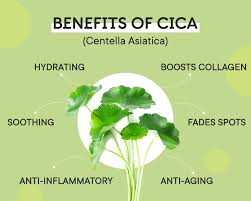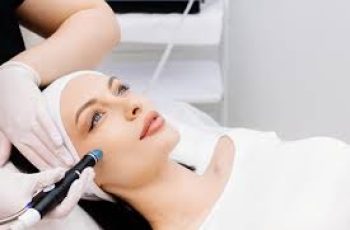
Skincare Benefits of Cica (Centella Asiatica)
Cica, centella asiatica, tiger grass, this herb goes by many names and has established itself as a highly desired ingredient in the skincare industry, particularly in K-beauty which we all know has an enormous following. So, what is it about this herb that makes it so popular?
What is Cica or Centella Asiatica?
Centella Asiatica, also called Cica is a botanical herb found growing in tropical, swampy areas throughout parts of Asia. Extracts of the herb have been used in natural Chinese medicine for thousands of years due to its skin healing properties. You may also find that products containing cica have the name “tiger grass” in the label, this comes from wild tigers being seen to roll amongst the plants to help treat any battle wounds they have and to rejuvenate their skin.
Well known for its healing, skin-soothing, antibacterial and inflammatory properties making it great for skin conditions such as eczema, psoriasis and scarring. It is also incredibly moisturising to help dry skin types!
With our busy and hectic lifestyle, our skin is usually prone to becoming quite imbalanced from lack of sleep and environmental aggressors. Cica has the ability to strengthen the skin’s barrier and improve the overall appearance giving you a clearer complexion. There is a huge list of benefits of cica and it has grown in popularity amongst skincare brands, making it a regular ingredient found in various products on the market such as moisturiser and even CC cream.
What are the skin benefits of cica or Centella Asiatica?
Anti- Ageing
Centella Asiatica is high in antioxidants that help to neutralise free radicals found in pollution and the sun’s UV rays. These free radicals cause damage to the skin’s barrier resulting in uneven skin tone and other concerns that are linked to skin ageing. Once the skin begins to age you will find that the loss of elasticity will cause the skin to droop and appear crepe-y. Cica is able to improve blood circulation and production of collagen resulting in the face looking more youthful and firm with reduced lines and wrinkles.
Soothing
Centella Asiatica contains asiaticosides which are incredibly soothing and healing for the skin. Sensitive and extremely dry skin types which suffer from redness, inflamed and sometimes itchy skin will see marked results in the comfort of their skin with visible signs of any irritation significantly reduced.
Moisturising
Not only is cica packed with antioxidants it is enriched with amino acids, fatty acids and beta carotene all of which provide huge amounts of nutrients for the skin making it hydrated and restoring the oil and water levels back to the skin’s barrier.
Healing
Cica can help with many skin conditions such as eczema, psoriasis, varicose veins and stretch marks. Centella contains “Madecassoside” which is a compound that boosts the antioxidant activity of the skin allowing any wounds or scars to become healed with an increase of blood circulation and strengthening the skin barrier. For those who suffer from blemish-prone skin, they will find that any breakouts, like spots, can be treated and cleared without any marks or scarring left behind.
Where can you find Cica?
Skincare – with the K-beauty popularity of this ingredient you will find it a vast selection of skincare products, such as serums, moisturiser and balms.
Topical- Cica can be applied topically on burns, scars, inflammation and stretch marks.
Supplements- you will also find cica is available in supplements to be taken orally which helps with improving circulation.
Cuisine- it will appear that the popularity of this plant reaches the kitchen with many cultures adding it to salads and rice dishes.
Can cica or Centella Asiatica help treat spots?
As previously mentioned cica has many skin benefits, one of the main ones being its anti-inflammatory properties. With active levels of the compound Madecassic, cica is able to reduce and calm any inflammation. This allows anyone who suffers from a blemish-prone skin to regulate their skin with ease and reduce any redness and size that is consistent with the appearance of spots and pimples. This natural ingredient is able to reduce the appearance and also keeps the skin clear from any further breakouts with thanks to the anti-bacterial properties.
What are the side effects of cica?
Some side effects of Centella Asiatica include:
Nausea
Upset stomach
Photosensitivity (sensitivity to sunlight)
Drowsiness
Burning
Itching
If you find you are suffering from any of those side effects than it is best to stop consuming and using any products containing Centella Asiatica.
There are some more severe side effects and if they occur seek medical help immediately:
Yellowing of the eyes
Low fever
Stomach pain
Clay-coloured stools
Should you have any questions or concerns with using cica contact your GP or dermatologist for more advice.
Should I use cica with other skin ingredients?
Though Centella Asiatica is powerful enough to work wonders on your skin single handily, there are some regularly used ingredients that can enhance the effects on the skin.
Centella Asiatica & Aloe Vera
Teaming these two together becomes the ultimate spot battling combination. Centella is able to reduce any inflammation and kills off any spot forming bacteria from the skin. By teaming this with aloe vera you are able to soothe and heal any breakouts quicker than before making your skin calm and happy.
Centella Asiatica & Vitamin C
As mentioned previously, Centella Asiatica gives a powerful boost for collagen production and when teamed with vitamin C significantly improve skin suppleness, firmness and hydration and improves the appearance of wrinkles after only 6 weeks of using. If you are wanting to find out more about vitamin C check out our blog post about its skin benefits.
Centella Asiatica & Glycolic Acid
By joining Centella and the AHA glycolic acid together you will find the skin has an uneven texture and a youthful, supple skin. Glycolic also aids the production of collagen in the skin and so gives Centella a supercharged boost.
So, there you have a little more insight into the ancient herb that took the beauty industry by storm and shows no signs of leaving the scene any time soon. Well, if it’s good enough for the king of the jungle, it’s good enough for us!
Don’t miss out on more skincare tips and expert advice over on our YouTube channel! Come and find us on The Green Sofa by hitting the subscribe button, you won’t regret it!
DQH Knowledge drop: In your 20s, your skin cell turnover decreases. (Cell turnover is a key component in keeping your skin youthful.) You know what else slows down? Your collagen production. Starting in your 20s, collagen decreases by about 1 percent per year. Should you want to prevent fine lines and wrinkles, start by eliminating behaviors that contribute to premature aging. “If it’s bad for you, it’s bad for your skin,” says dermatologist Michel Somenek.
“Cigarette smoking reduces blood flow to the skin and causes premature wrinkling and a dull skin texture. Making the repeated pursed motion to inhale can also cause smoker’s lines. Alcohol and recreational drugs are toxins for the skin that damage its cellular structure and DNA,” Somenek tells us. “The faster you eliminate vices while you are young, the better chance your skin and body have to recuperate.” Also, adopting an anti-aging routine in your 20s is key. After all, the best offense is a good defense. We spoke to Somenek and experts Joshua Ross and Audrey Kunin to find out more.
Keep reading for the best anti-aging products for your 20s, according to skincare professionals.
Sunscreen
“We all know that the sun is the number one cause of skin aging and starting the prevention in your 20s is very important,” Ross says. “The majority of your sun damage won’t start to appear until you’re in your 30s, so don’t wait until you see it surface or you’ll be behind the curve. Stay ahead of it with a good-quality zinc-based sunscreen worn daily.”
Farmacy Green Defense Daily Mineral Sunscreen
An invisible sunscreen with SPF 30, plus botanical extracts meant to protect skin with tons of antioxidants. Bonus: It’s clean and fine to use under makeup.
Bareminerals Complexion Rescue™ Tinted Moisturizer Broad Spectrum SPF 30
Although we recommend you use your SPF and moisturizer separately, we also understand moments when you don’t have time or energy for that extra step. For those times, this bareMinerals moisturizer is a great thing to have on hand.
Vitamin C Serum
“A great introduction to anti-aging is to start with a vitamin C serum in your morning skincare routine,” Ross says. “It’s a powerful antioxidant that will neutralize free radicals and brighten the skin.” He adds that it’s a great way to counteract the effects of the sun’s harmful rays, which, as previously mentioned, are among the biggest causes of premature aging.
Drunk Elephant C-Firma™ Vitamin C Day Serum
The Drunk Elephant C-Firma is a lightweight serum that promises to give skin a glow by combining the brightening powers of vitamin C with ferulic acid, l-ascorbic acid, and vitamin E. The included sodium hyaluronate is meant to replace hydration loss, so you shouldn’t have to deal with any irritation.
Sunday Riley C.E.O. Rapid Flash Brightening Serum
This potent serum is jam-packed with vitamin C (15 percent, to be exact), which means it’s a potential superstar at both brightening skin and dousing it in antioxidants.
Peptides
Using peptides on your skin has many benefits, says Somenek. “The skin barrier is what defends the body against pollution, UV rays, bacteria, and toxins. It can be damaged by several everyday factors. Using topical peptides aids in building a stronger barrier,” he says. “Peptides comprise elastic fibers, which are a type of protein. These fibers help to make skin appear taut and firm. Peptides can also help repair damaged skin, relieve inflammation, and even out skin tone. Some peptides can kill acne-causing bacteria that is common in 20-somethings.”
Kunin agrees, saying, “Peptides are an excellent entry point for supporting collagen.” She recommends looking for face and eye treatments that contain these collagen-boosting powerhouses.
Charlotte Tilbury Magic Eye Rescue Cream
This Charlotte Tilbury super-emollient eye cream has a base of coconut oil and shea butter (read: it’s incredibly hydrating). Botanicals plus peptides are meant to help reduce dark circles and boost collagen, respectively.
This creamy moisturizer serves up potent collagen-boosting peptides and pycnogenol, and antioxidant-rich vitamin C. “Instead of sitting on top of the skin, peptides penetrate the outer layer so they go deep. The ‘signals’ they send tell the cells to produce elastin and collagen, which are needed for youthful-looking skin,” explains Somenek.
At-Home Peel Pads
Remember that skin cell turnover fiasco we talked about earlier? One way to help support it is by exfoliating. “Exfoliation is important to help keep skin fresh and luminous,” Kunin says. She recommends using at-home peel pads as an easy and effective way to exfoliate.
“The goal in your 20s is to fight the slowing pace of cell turnover. It is wise to use products that gently exfoliate, yet still remove oil and other impurities. Products that have Alpha Hydroxy Acids (AHA) or Beta Hydroxy Acids (BHA) are a good choice.”
According to Somenek, you should only exfoliate two to three times a week. “People of all ages are guilty of over-exfoliating and that can be too much of a good thing,” he says.
Dermadoctor Kakadu C Intensive Vitamin C Peel Pad
A few swipes of this Derma Doctor powerful peel pad promise to leave your skin glowing and smooth, thanks to the seven (yes, seven) types of chemical exfoliants, including AHA and BHA. It also contains vitamin C via Kakadu plum extract for added brightening and antioxidant protection.
KEY INGREDIENTS Kakadu plum extract is sourced from the Kakadu plum, a fruit grown in northern Australia. It contains vitamin C, which restores the skin’s natural barrier, increases collagen production, and soothes irritation.
Dr. Dennis Gross Skincare Alpha Beta® Universal Daily Peel Pads
These are the gold standard of peel pads, with a cult following and over 900 five-star reviews on Sephora. They’re easy to use and contain a blend of anti-aging exfoliating acids.
Emollient Night Cream
“In your 20s, you need to start upping the hydration in your skincare routine. You may have been cautious of over-moisturizing because of acne in your teens, but as you enter your 20s, your skin transitions and becomes drier,” Ross says. “I recommend an emollient night cream added into your evening skincare regimen.”
“Twenty-somethings need to make sure that they are not using creams that will clog their pores and cause excess oil production,” says Somenek. Opt for non-comedogenic products.
Cerave Skin Renewing Night Cream
One great choice is the CeraVe Skin Renewing Night Cream, which is a non-comedogenic night cream that leaves skin soft and glowy. It combines the moisturizing powers of ceramides and hyaluronic acid.
RoC Retinol Correxion Max Hydration Creme
“The best night cream ingredients contain retinol, benzoyl peroxide, and/or salicylic acid or hyaluronic acid. The goal is to moisturize, yet remove excess oil,” says Somenek. This Roc Retinol Correxion cream fits the bill as it contains both hyaluronic acid and retinol so it promises to moisturize while also being non-comedogenic.



